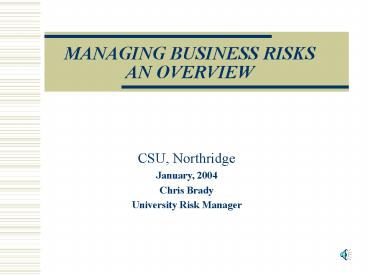MANAGING BUSINESS RISKS AN OVERVIEW - PowerPoint PPT Presentation
Title:
MANAGING BUSINESS RISKS AN OVERVIEW
Description:
Expand your knowledge base of risk ... Loss History Program Outlines Annual Budget Meeting Agendas Purchase Agreements Inspection and Maintenance ... – PowerPoint PPT presentation
Number of Views:246
Avg rating:3.0/5.0
Title: MANAGING BUSINESS RISKS AN OVERVIEW
1
MANAGING BUSINESS RISKSAN OVERVIEW
- CSU, Northridge
- January, 2004
- Chris Brady
- University Risk Manager
2
WHAT IS RISK MANAGEMENT?
- Risk The organizations exposure to accidental
loss. - Management Planning, organizing, Leading and
controlling. - Everyone on campus must be a risk manager.
3
Classic risk management is no longer adequate
4
IN ORDER TO MANAGE RISK EFFECTIVELY YOU MUST
- Understand risks associated with your objective.
- Understand your role as a part of the CSUN Risk
Management Team. - Expand your knowledge base of risk management
principles. - Take an active role in the risk management effort
at CSUN. - Seek creative solutions to risk management issues.
5
Why Managing Risk Is Important
- Accountability
- Raises Awareness
- Financial impacts
- Program cuts
- Premiums
- Deductibles
- Claims
6
CSUN Insurance Contributions (Premiums)
7
CSUN Insurance Contributions (Premiums)
4,169,434
8
Benefits of Hands-OnRisk Management
- Increases awareness of objectives
- Puts focus on mission critical objectives
- Clear understanding of responsibility
accountability - Improves cross-functional communication
- Creates a sense of TEAM-OWNERSHIP
- Early identification of risks can result in
mitigation activity that significantly reduces
exposure
9
SIX STEPS OF RISK MANAGEMENT
- 1. Identify and Analyze Exposures
- 2. Analyze Feasibility of Alternative
Techniques - 3. Select Method of Risk Control
- 4. Implement Chosen Techniques
- 5. Monitor Results
- 6. Modify Techniques
10
STEP 1 Identify Analyze Exposures
- Identification Tools
- Loss History
- Program Outlines
- Annual Budget
- Meeting Agendas
- Purchase Agreements
- Inspection and Maintenance Records
- Contracts and Leases
11
STEP 2 Feasibility of Alternative Techniques
- Avoidance
- Transfer of Risk
- Retention of Risk
- Reduce Risk through Loss Reduction Efforts
- Finance Retained Risk
- Define Meaningful Standards and Expectations
12
STEP 3 Evaluate Loss Potential
- Evaluation Techniques
- Frequency/Severity of Claims
- Publications/Periodicals/Other Universities
- Political/Litigation Climate
- Anticipate
13
MITIGATION OPTIONS
- Control It (prevention detection techniques)
- Share It (co-source warrants guarantees)
- Transfer It (insurance hold harmless contracts)
- Avoid It (process re-design eliminate process)
- Accept It (cost/benefit analysis)
- Residual Risk (Opportunity To Manage)
14
STEP 4 Implement Chosen Technique
- Management Support
- Documentation and Notification
- Governing Board Approval for Major Actions
- Develop Policies and Procedures
15
STEP 5 Monitor Results
- Compare Actual Results to Anticipated Results
- Consider Environmental Changes
- Keep Records/Documents
16
STEP 6 Modify Techniques to Reflect experience
- Document Decision Making Process
- Maintain a Safety/Loss Control Program
- Continue to Monitor Results
- Start over at Step 1 !!!
17
CURRENT CHALLENGES
- Changing environment remodel
- Budget issues Circumvent procedures/taking
shortcuts - Policies Procedures Clearly defined
- Safety environment Constant changes
- Communication Sharing of information
- Equipment Purchasing Insurance requirements
- Maintain a teamwork philosophy, share
information, focus on the objective of the
college and the impact to future programs.
18
RISK RELATED ACTIVITIES
- Lab Environment
- Project design testing
- Competitions
- Internships
- Field Trips
- Proper planning, training and supervision for
these types of activities will significantly
reduce the risk of loss, damage or injury.
19
For Assistance With
- Insurance Issues
- Risk Assessments
- Ergonomic Assessments
- Compliance Monitoring
- Claim Management
- Training Staff Development
Insurance Risk Management at ext. 2401
20
Questions Answers































